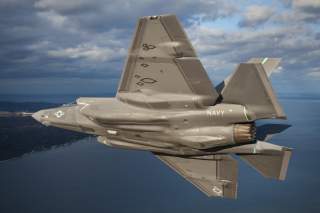Get Ready, North Korea: The F-35 Is Almost Ready to Attack from Aircraft Carriers
And that is a big deal.
The aircraft has gone through several rounds of testing to advance what’s called carrier integration and carrier qualification – an effort to seamlessly integrate the new aircraft into the carrier platform and carrier air wing, service officials have explained.
Stealthy F-35C carrier aircraft, having a lower radar signature, are expected to deliver advanced attack and air-to-air and intelligence, surveillance and reconnaissance platforms, able to perform a wider range of operations without being detected by an enemy.
The aircraft is part of a broader Navy strategy to be well equipped in the event that it needs to engage in massive, major-power war against a near-peer adversary such as Russia and China known to have advanced air-defenses and air-to-air platforms.
The F-35C - the Navy's and Marine Corps' carrier-suitable variant (CV) – is designed to combined unprecedented at-sea stealth with fighter speed and agility, fused targeting, cutting-edge avionics, advanced jamming, network-enabled operations and advanced sustainment.
In a previously released document described as the "Naval Aviation Vision," the F-35C is described as being engineered with reinforced landing gear and durable coatings to allow the F-35C to withstand harsh shipboard conditions while delivering a lethal combination of fighter capabilities to the fleet.
In recent years, the F-35 has been completing stages of Developmental Testing III, or DT-III, as the third of three at-sea test phases for the F-35C. Naval aircraft are slated to go through DT-I, -II and -III test phases in order to ensure the development of aircraft meets specifications and properly identifies mission critical issues sufficiently early in the test phase.
Two F-35C Lightning II carrier variants conducted their first arrested landings aboard USS Dwight D. Eisenhower (CVN 69) off the coast of the eastern United States on Oct. 2, 2015.
By 2025, the Navy's aircraft carrier-based air wings will consist of a mix of F-35C, F/A-18E/F Super Hornets, EA-18G Growlers electronic attack aircraft, E-2D Hawkeye battle management and control aircraft, MH-60R/S helicopters and Carrier Onboard Delivery logistics aircraft such as the emerging Navy Osprey tiltrotor aircraft variant.
Lockheed Martin is the aircraft contractor and Pratt & Whitney is the engine contractor. Several reports, including on from “War is Boring,” cite the F-35C cost per plane as more than $337 million.
Recommended: 5 Most Powerful Aircraft Carriers, Subs, Bombers and Fighter Aircraft Ever
Recommended: North Korea Has 200,000 Soldiers in Its Special Forces
Recommended: Why Doesn't America Kill Kim Jong Un?

